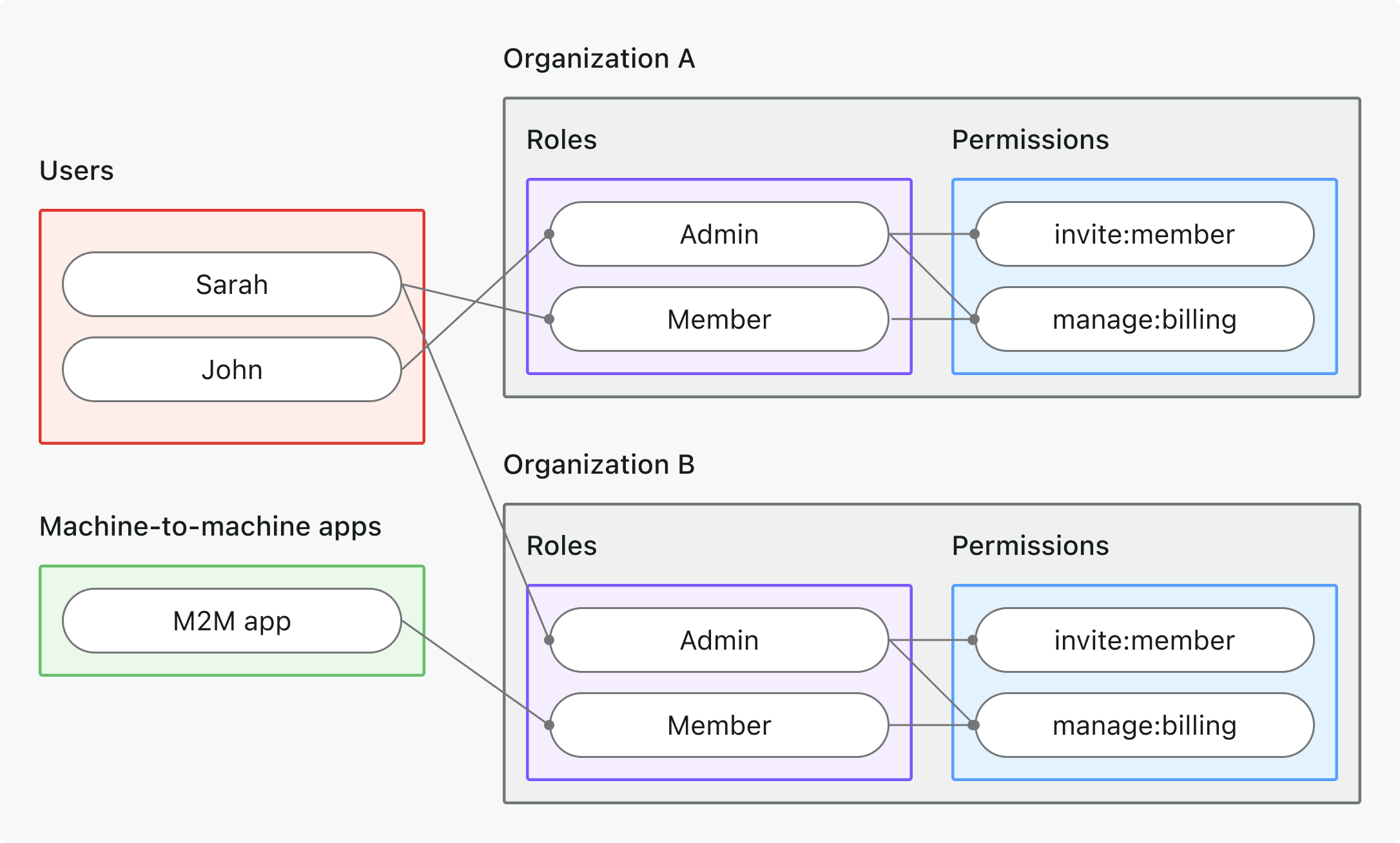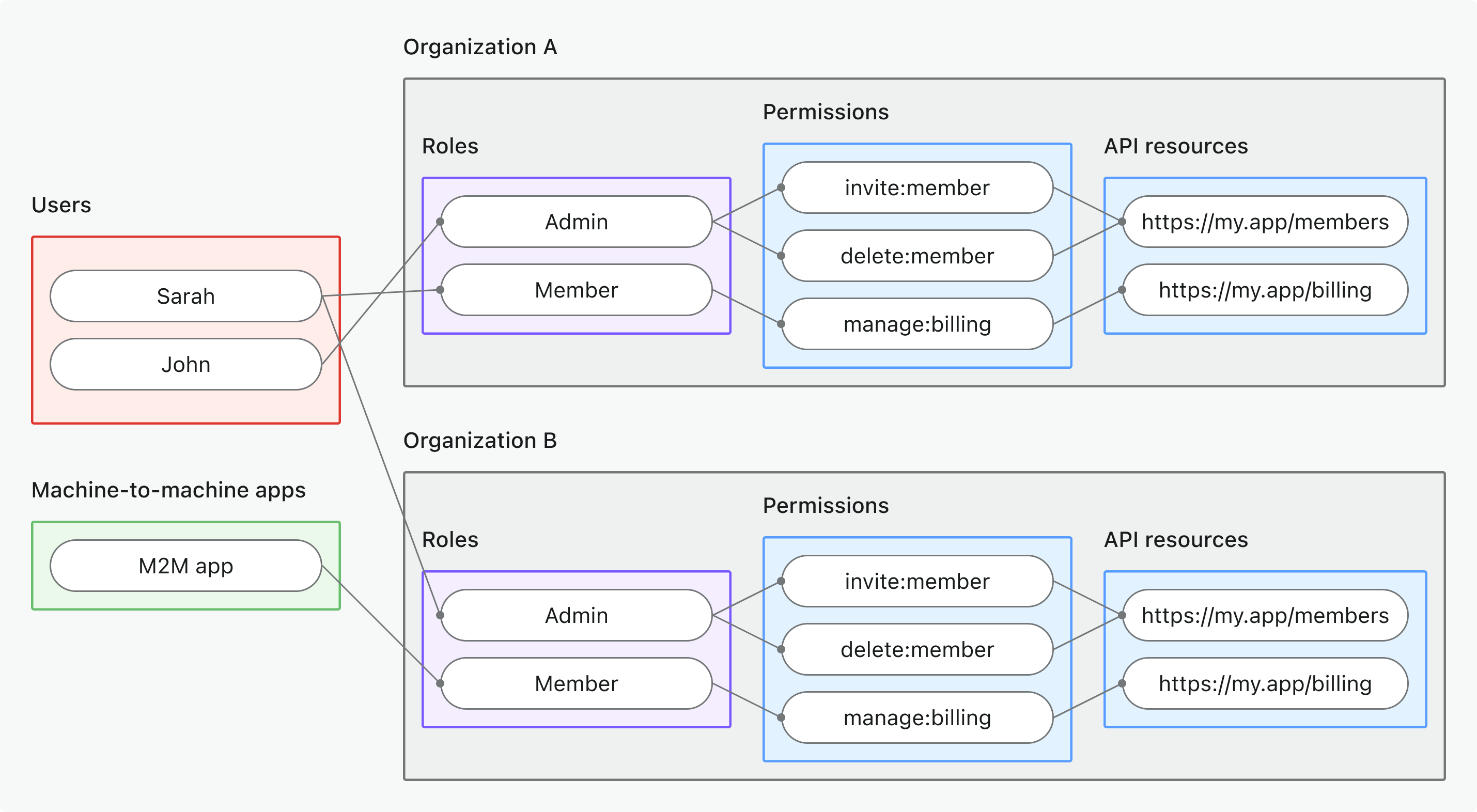使用 RBAC 與 JWT 驗證 (JWT validation) 保護你的 Symfony API
本指南將協助你透過 角色型存取控制 (RBAC, Role-based access control) 以及由 Logto 簽發的 JSON Web Token (JWT),為你的 Symfony API 實作授權 (Authorization) 機制。
開始前
你的用戶端應用程式需要從 Logto 取得存取權杖 (Access tokens)。如果你尚未完成用戶端整合,請參考我們針對 React、Vue、Angular 或其他前端框架的 快速入門,或伺服器對伺服器存取請參閱 機器對機器指南。
本指南聚焦於在你的 Symfony 應用程式中,對這些權杖進行伺服器端驗證。

你將學到
- JWT 驗證: 學習如何驗證存取權杖 (Access tokens) 並擷取驗證 (Authentication) 資訊
- 中介軟體實作: 建立可重複使用的中介軟體以保護 API
- 權限模型: 理解並實作不同的授權 (Authorization) 模式:
- 全域 API 資源 (Global API resources) 用於應用程式層級端點
- 組織權限 (Organization permissions) 控制租戶專屬功能
- 組織層級 API 資源 (Organization-level API resources) 用於多租戶資料存取
- RBAC 整合: 在 API 端點強制執行角色型權限 (Role-based permissions) 與權限範圍 (Scopes)
先決條件
- 已安裝最新版穩定版 PHP
- 基本了解 Symfony 與 Web API 開發
- 已設定 Logto 應用程式(如有需要請參閱 快速入門)
權限 (Permission) 模型總覽
在實作保護機制前,請先選擇最適合你應用程式架構的權限模型。這與 Logto 的三大授權 (Authorization) 情境相符:
- 全域 API 資源 (Global API resources)
- 組織(非 API)權限 (Organization (non-API) permissions)
- 組織層級 API 資源 (Organization-level API resources)

- 適用情境: 保護整個應用程式共用的 API 資源(非組織專屬)
- 權杖類型: 具有全域受眾 (global audience) 的存取權杖 (Access token)
- 範例: 公開 API、核心產品服務、管理端點
- 最適用於: 所有客戶共用 API 的 SaaS 產品、無租戶隔離的微服務架構
- 深入瞭解: 保護全域 API 資源

- 適用情境: 控制組織專屬的操作、UI 功能或商業邏輯(非 API)
- 權杖類型: 具有組織專屬受眾 (organization-specific audience) 的組織權杖 (Organization token)
- 範例: 功能開關、儀表板權限、成員邀請控制
- 最適用於: 具有組織專屬功能與流程的多租戶 SaaS
- 深入瞭解: 保護組織(非 API)權限

- 適用情境: 保護僅在特定組織情境下可存取的 API 資源
- 權杖類型: 具有 API 資源受眾 (API resource audience) + 組織情境 (organization context) 的組織權杖 (Organization token)
- 範例: 多租戶 API、組織範圍資料端點、租戶專屬微服務
- 最適用於: API 資料以組織為範圍的多租戶 SaaS
- 深入瞭解: 保護組織層級 API 資源
💡 請在繼續前選擇你的模型 —— 本指南後續內容將以你選擇的方式為參考。
快速準備步驟
設定 Logto 資源與權限 (Permissions)
- 全域 API 資源 (Global API resources)
- 組織(非 API)權限 (Organization (non-API) permissions)
- 組織層級 API 資源 (Organization-level API resources)
- 建立 API 資源 (API resource): 前往 Console → API 資源 (API resources) 並註冊你的 API(例如:
https://api.yourapp.com) - 定義權限 (Permissions): 新增如
read:products、write:orders等權限範圍 (Scopes) —— 參考 定義帶有權限的 API 資源 - 建立全域角色 (Global roles): 前往 Console → 角色 (Roles) 並建立包含 API 權限的角色 —— 參考 設定全域角色
- 指派角色 (Assign roles): 將角色指派給需要 API 存取權的使用者或 M2M 應用程式
- 定義組織權限 (Organization permissions): 在組織範本中建立如
invite:member、manage:billing等非 API 組織權限 - 設定組織角色 (Organization roles): 在組織範本中配置組織專屬角色並指派權限給這些角色
- 指派組織角色 (Assign organization roles): 在每個組織情境下將使用者指派到組織角色
- 建立 API 資源 (API resource): 如上註冊你的 API 資源,但將用於組織情境
- 定義權限 (Permissions): 新增如
read:data、write:settings等限定於組織情境的權限範圍 (Scopes) - 設定組織範本 (Configure organization template): 設定包含 API 資源權限的組織角色
- 指派組織角色 (Assign organization roles): 將使用者或 M2M 應用程式指派到包含 API 權限的組織角色
- 多租戶設定 (Multi-tenant setup): 確保你的 API 能處理組織範圍的資料與驗證
建議從我們的 角色型存取控制 (RBAC) 指南 開始,獲得逐步設定說明。
更新你的用戶端應用程式
在用戶端請求適當的權限範圍 (Scopes):
- 使用者驗證 (Authentication):更新你的應用程式 → 以請求你的 API 權限範圍和/或組織情境
- 機器對機器 (M2M):設定 M2M 權限範圍 → 以進行伺服器對伺服器存取
通常需要在用戶端設定中新增以下一項或多項:
- OAuth 流程中的
scope參數 - 用於 API 資源存取的
resource參數 - 組織情境下的
organization_id
請確保你測試的使用者或 M2M 應用程式已被指派包含所需 API 權限的正確角色或組織角色。
初始化你的 API 專案
要初始化一個新的 Symfony 專案以進行 API 開發,可以使用 Symfony CLI 或 Composer:
推薦使用 Symfony CLI:
symfony new your-api-name --webapp
cd your-api-name
或使用 Composer:
composer create-project symfony/skeleton your-api-name
cd your-api-name
composer require webapp
安裝額外的 API 開發套件:
composer require symfony/security-bundle
composer require symfony/serializer
composer require doctrine/annotations
啟動開發伺服器:
symfony serve
或使用 PHP 內建伺服器:
php -S localhost:8000 -t public/
這樣會建立一個基本的 Symfony 專案。接著設定框架以支援 API 開發:
framework:
secret: '%env(APP_SECRET)%'
serializer:
enabled: true
property_access:
enabled: true
更多關於如何設定控制器、服務與其他功能,請參考 Symfony 官方文件。
初始化常數與工具函式
在你的程式碼中定義必要的常數與工具函式,以處理權杖(token)的擷取與驗證。一個有效的請求必須包含 Authorization 標頭,格式為 Bearer <存取權杖 (Access token)>。
<?php
class AuthConstants
{
public const JWKS_URI = 'https://your-tenant.logto.app/oidc/jwks';
public const ISSUER = 'https://your-tenant.logto.app/oidc';
}
<?php
class AuthInfo
{
public function __construct(
public readonly string $sub,
public readonly ?string $clientId = null,
public readonly ?string $organizationId = null,
public readonly array $scopes = [],
public readonly array $audience = []
) {}
public function toArray(): array
{
return [
'sub' => $this->sub,
'client_id' => $this->clientId,
'organization_id' => $this->organizationId,
'scopes' => $this->scopes,
'audience' => $this->audience,
];
}
}
<?php
class AuthorizationException extends Exception
{
public function __construct(
string $message,
public readonly int $statusCode = 403
) {
parent::__construct($message);
}
}
<?php
trait AuthHelpers
{
protected function extractBearerToken(array $headers): string
{
$authorization = $headers['authorization'][0] ?? $headers['Authorization'][0] ?? null;
if (!$authorization) {
throw new AuthorizationException('Authorization 標頭缺失 (Authorization header is missing)', 401);
}
if (!str_starts_with($authorization, 'Bearer ')) {
throw new AuthorizationException('Authorization 標頭必須以 "Bearer " 開頭 (Authorization header must start with "Bearer ")', 401);
}
return substr($authorization, 7); // 移除 'Bearer ' 前綴 (Remove 'Bearer ' prefix)
}
}
取得你的 Logto 租戶資訊
你需要以下數值來驗證 Logto 發行的權杖:
- JSON Web Key Set (JWKS) URI:Logto 公鑰的網址,用於驗證 JWT 簽章。
- 簽發者 (Issuer):預期的簽發者值(Logto 的 OIDC URL)。
首先,找到你的 Logto 租戶端點。你可以在多個地方找到:
- 在 Logto Console,設定 → 網域。
- 在你於 Logto 配置過的任何應用程式設定中,設定 → 端點與憑證。
從 OpenID Connect 探索端點取得
這些數值可以從 Logto 的 OpenID Connect 探索端點取得:
https://<your-logto-endpoint>/oidc/.well-known/openid-configuration
以下為範例回應(為簡潔省略其他欄位):
{
"jwks_uri": "https://your-tenant.logto.app/oidc/jwks",
"issuer": "https://your-tenant.logto.app/oidc"
}
在程式碼中硬編碼(不建議)
由於 Logto 不允許自訂 JWKS URI 或簽發者 (Issuer),你可以將這些數值硬編碼在程式碼中。但這不建議用於正式環境,因為若未來有設定變更,可能會增加維護負擔。
- JWKS URI:
https://<your-logto-endpoint>/oidc/jwks - 簽發者 (Issuer):
https://<your-logto-endpoint>/oidc
驗證權杖與權限
在擷取權杖並取得 OIDC 設定後,請驗證以下項目:
- 簽章 (Signature): JWT 必須有效且由 Logto(透過 JWKS)簽署。
- 簽發者 (Issuer): 必須符合你的 Logto 租戶簽發者。
- 受眾 (Audience): 必須符合在 Logto 註冊的 API 資源標示符 (resource indicator),或在適用時符合組織 (Organization) 上下文。
- 過期時間 (Expiration): 權杖不得過期。
- 權限範圍 (Permissions, scopes): 權杖必須包含 API/操作所需的權限範圍 (scopes)。scopes 會以空格分隔字串出現在
scope宣告 (claim) 中。 - 組織 (Organization) 上下文: 若保護的是組織層級 API 資源,需驗證
organization_id宣告 (claim)。
詳情請參閱 JSON Web Token 以瞭解 JWT 結構與宣告 (claims)。
各權限模型需檢查的項目
不同權限模型下,宣告 (claims) 與驗證規則有所不同:
- 全域 API 資源
- 組織(非 API)權限
- 組織層級 API 資源
- 受眾宣告 (
aud): API 資源標示符 (API resource indicator) - 組織宣告 (
organization_id): 不存在 - 權限範圍需檢查 (
scope): API 資源權限 (API resource permissions)
- 受眾宣告 (
aud):urn:logto:organization:<id>(組織上下文於aud宣告中) - 組織宣告 (
organization_id): 不存在 - 權限範圍需檢查 (
scope): 組織權限 (Organization permissions)
- 受眾宣告 (
aud): API 資源標示符 (API resource indicator) - 組織宣告 (
organization_id): 組織 ID(必須與請求相符) - 權限範圍需檢查 (
scope): API 資源權限 (API resource permissions)
對於非 API 組織權限,組織上下文由 aud 宣告表示 (例如
urn:logto:organization:abc123)。organization_id 宣告僅存在於組織層級 API 資源權杖中。
對於多租戶 API,務必同時驗證權限範圍 (scopes) 及上下文(受眾 (audience)、組織 (organization)),以確保安全。
新增驗證邏輯
我們使用 firebase/php-jwt 來驗證 JWT。請使用 Composer 安裝:
composer require firebase/php-jwt
首先,新增這些共用工具來處理 JWT 驗證:
<?php
use Firebase\JWT\JWT;
use Firebase\JWT\JWK;
use Firebase\JWT\Key;
class JwtValidator
{
use AuthHelpers;
private static ?array $jwks = null;
public static function fetchJwks(): array
{
if (self::$jwks === null) {
$jwksData = file_get_contents(AuthConstants::JWKS_URI);
if ($jwksData === false) {
throw new AuthorizationException('Failed to fetch JWKS', 401);
}
self::$jwks = json_decode($jwksData, true);
}
return self::$jwks;
}
public static function validateJwt(string $token): array
{
try {
$jwks = self::fetchJwks();
$keys = JWK::parseKeySet($jwks);
$decoded = JWT::decode($token, $keys);
$payload = (array) $decoded;
// 驗證簽發者 (issuer)
if (($payload['iss'] ?? '') !== AuthConstants::ISSUER) {
throw new AuthorizationException('Invalid issuer', 401);
}
self::verifyPayload($payload);
return $payload;
} catch (AuthorizationException $e) {
throw $e;
} catch (Exception $e) {
throw new AuthorizationException('Invalid token: ' . $e->getMessage(), 401);
}
}
public static function createAuthInfo(array $payload): AuthInfo
{
$scopes = !empty($payload['scope']) ? explode(' ', $payload['scope']) : [];
$audience = $payload['aud'] ?? [];
if (is_string($audience)) {
$audience = [$audience];
}
return new AuthInfo(
sub: $payload['sub'],
clientId: $payload['client_id'] ?? null,
organizationId: $payload['organization_id'] ?? null,
scopes: $scopes,
audience: $audience
);
}
private static function verifyPayload(array $payload): void
{
// 根據權限模型實作你的驗證邏輯
// 相關內容會在下方權限模型區段展示
}
}
接著,實作 middleware 來驗證存取權杖 (access token):
<?php
namespace App\Security;
use Symfony\Component\HttpFoundation\JsonResponse;
use Symfony\Component\HttpFoundation\Request;
use Symfony\Component\HttpFoundation\Response;
use Symfony\Component\Security\Core\Authentication\Token\TokenInterface;
use Symfony\Component\Security\Core\Exception\AuthenticationException;
use Symfony\Component\Security\Http\Authenticator\AbstractAuthenticator;
use Symfony\Component\Security\Http\Authenticator\Passport\Badge\UserBadge;
use Symfony\Component\Security\Http\Authenticator\Passport\Passport;
use Symfony\Component\Security\Http\Authenticator\Passport\SelfValidatingPassport;
class JwtAuthenticator extends AbstractAuthenticator
{
use AuthHelpers;
public function supports(Request $request): ?bool
{
return $request->headers->has('authorization');
}
public function authenticate(Request $request): Passport
{
try {
$token = $this->extractBearerToken($request->headers->all());
$payload = JwtValidator::validateJwt($token);
$authInfo = JwtValidator::createAuthInfo($payload);
// 將驗證資訊存入 request 屬性以便通用使用
$request->attributes->set('auth', $authInfo);
return new SelfValidatingPassport(new UserBadge($payload['sub']));
} catch (AuthorizationException $e) {
throw new AuthenticationException($e->getMessage());
}
}
public function onAuthenticationSuccess(Request $request, TokenInterface $token, string $firewallName): ?Response
{
return null; // 繼續進入 controller
}
public function onAuthenticationFailure(Request $request, AuthenticationException $exception): ?Response
{
return new JsonResponse(['error' => $exception->getMessage()], Response::HTTP_UNAUTHORIZED);
}
}
在 config/packages/security.yaml 中設定安全性:
security:
firewalls:
api:
pattern: ^/api/protected
stateless: true
custom_authenticators:
- App\Security\JwtAuthenticator
根據你的權限模型,在 JwtValidator 中實作對應的驗證邏輯:
- 全域 API 資源 (Global API resources)
- 組織(非 API)權限 (Organization (non-API) permissions)
- 組織層級 API 資源 (Organization-level API resources)
private static function verifyPayload(array $payload): void
{
// 檢查 audience 宣告是否符合你的 API 資源標示符 (resource indicator)
$audiences = $payload['aud'] ?? [];
if (is_string($audiences)) {
$audiences = [$audiences];
}
if (!in_array('https://your-api-resource-indicator', $audiences)) {
throw new AuthorizationException('Invalid audience');
}
// 檢查全域 API 資源所需權限範圍 (scopes)
$requiredScopes = ['api:read', 'api:write']; // 請替換為實際所需權限範圍
$scopes = !empty($payload['scope']) ? explode(' ', $payload['scope']) : [];
foreach ($requiredScopes as $scope) {
if (!in_array($scope, $scopes)) {
throw new AuthorizationException('Insufficient scope');
}
}
}
private static function verifyPayload(array $payload): void
{
// 檢查 audience 宣告是否符合組織格式
$audiences = $payload['aud'] ?? [];
if (is_string($audiences)) {
$audiences = [$audiences];
}
$hasOrgAudience = false;
foreach ($audiences as $aud) {
if (str_starts_with($aud, 'urn:logto:organization:')) {
$hasOrgAudience = true;
break;
}
}
if (!$hasOrgAudience) {
throw new AuthorizationException('Invalid audience for organization permissions');
}
// 檢查組織 ID 是否與情境相符(你可能需要從請求內容取得)
$expectedOrgId = 'your-organization-id'; // 從請求內容取得
$expectedAud = "urn:logto:organization:{$expectedOrgId}";
if (!in_array($expectedAud, $audiences)) {
throw new AuthorizationException('Organization ID mismatch');
}
// 檢查所需組織權限範圍 (scopes)
$requiredScopes = ['invite:users', 'manage:settings']; // 請替換為實際所需權限範圍
$scopes = !empty($payload['scope']) ? explode(' ', $payload['scope']) : [];
foreach ($requiredScopes as $scope) {
if (!in_array($scope, $scopes)) {
throw new AuthorizationException('Insufficient organization scope');
}
}
}
private static function verifyPayload(array $payload): void
{
// 檢查 audience 宣告是否符合你的 API 資源標示符 (resource indicator)
$audiences = $payload['aud'] ?? [];
if (is_string($audiences)) {
$audiences = [$audiences];
}
if (!in_array('https://your-api-resource-indicator', $audiences)) {
throw new AuthorizationException('Invalid audience for organization-level API resources');
}
// 檢查組織 ID 是否與情境相符(你可能需要從請求內容取得)
$expectedOrgId = 'your-organization-id'; // 從請求內容取得
$orgId = $payload['organization_id'] ?? null;
if ($expectedOrgId !== $orgId) {
throw new AuthorizationException('Organization ID mismatch');
}
// 檢查組織層級 API 資源所需權限範圍 (scopes)
$requiredScopes = ['api:read', 'api:write']; // 請替換為實際所需權限範圍
$scopes = !empty($payload['scope']) ? explode(' ', $payload['scope']) : [];
foreach ($requiredScopes as $scope) {
if (!in_array($scope, $scopes)) {
throw new AuthorizationException('Insufficient organization-level API scopes');
}
}
}
套用中介軟體至你的 API
現在,將中介軟體套用到你受保護的 API 路由。
<?php
namespace App\Controller\Api;
use Symfony\Bundle\FrameworkBundle\Controller\AbstractController;
use Symfony\Component\HttpFoundation\JsonResponse;
use Symfony\Component\HttpFoundation\Request;
use Symfony\Component\Routing\Annotation\Route;
use Symfony\Component\Security\Http\Attribute\IsGranted;
#[Route('/api/protected')]
#[IsGranted('IS_AUTHENTICATED_FULLY')]
class ProtectedController extends AbstractController
{
#[Route('', methods: ['GET'])]
public function index(Request $request): JsonResponse
{
// 從 request 屬性取得驗證 (Authentication) 資訊
$auth = $request->attributes->get('auth');
return $this->json(['auth' => $auth->toArray()]);
}
}
測試你的受保護 API
取得存取權杖 (Access tokens)
從你的用戶端應用程式取得: 如果你已完成用戶端整合,你的應用程式可以自動取得權杖。擷取存取權杖 (Access token) 並在 API 請求中使用。
使用 curl / Postman 測試:
-
使用者權杖 (User tokens): 使用你的用戶端應用程式的開發者工具,從 localStorage 或網路分頁複製存取權杖 (Access token)
-
機器對機器權杖 (Machine-to-machine tokens): 使用 client credentials flow。以下是使用 curl 的非標準範例:
curl -X POST https://your-tenant.logto.app/oidc/token \
-H "Content-Type: application/x-www-form-urlencoded" \
-d "grant_type=client_credentials" \
-d "client_id=your-m2m-client-id" \
-d "client_secret=your-m2m-client-secret" \
-d "resource=https://your-api-resource-indicator" \
-d "scope=api:read api:write"你可能需要根據你的 API 資源 (API resource) 和權限 (Permissions) 調整
resource和scope參數;如果你的 API 以組織 (Organization) 為範圍,也可能需要organization_id參數。
需要檢查權杖內容嗎?請使用我們的 JWT 解碼工具 來解碼並驗證你的 JWT。
測試受保護端點
有效權杖請求
curl -H "Authorization: Bearer eyJhbGciOiJSUzI1NiIsInR5cCI6IkpXVCJ9..." \
http://localhost:3000/api/protected
預期回應:
{
"auth": {
"sub": "user123",
"clientId": "app456",
"organizationId": "org789",
"scopes": ["api:read", "api:write"],
"audience": ["https://your-api-resource-indicator"]
}
}
缺少權杖
curl http://localhost:3000/api/protected
預期回應 (401):
{
"error": "Authorization header is missing"
}
無效權杖
curl -H "Authorization: Bearer invalid-token" \
http://localhost:3000/api/protected
預期回應 (401):
{
"error": "Invalid token"
}
權限模型專屬測試
- 全域 API 資源 (Global API resources)
- 組織(非 API)權限 (Organization (non-API) permissions)
- 組織層級 API 資源 (Organization-level API resources)
針對以全域權限範圍 (Scopes) 保護的 API 測試情境:
- 有效權限範圍 (Valid scopes): 使用包含所需 API 權限範圍(如
api:read、api:write)的權杖測試 - 缺少權限範圍 (Missing scopes): 權杖缺少必要權限範圍時,預期回傳 403 Forbidden
- 錯誤受眾 (Wrong audience): 權杖受眾 (Audience) 不符合 API 資源時,預期回傳 403 Forbidden
# 權杖缺少必要權限範圍 - 預期 403
curl -H "Authorization: Bearer token-without-required-scopes" \
http://localhost:3000/api/protected
針對組織專屬存取控制的測試情境:
- 有效組織權杖 (Valid organization token): 使用包含正確組織 (Organization) 資訊(組織 ID 與權限範圍)的權杖測試
- 缺少權限範圍 (Missing scopes): 使用者沒有執行請求操作的權限時,預期回傳 403 Forbidden
- 錯誤組織 (Wrong organization): 權杖受眾 (Audience) 不符合組織上下文(
urn:logto:organization:<organization_id>)時,預期回傳 403 Forbidden
# 錯誤組織的權杖 - 預期 403
curl -H "Authorization: Bearer token-for-different-organization" \
http://localhost:3000/api/protected
結合 API 資源驗證與組織上下文的測試情境:
- 有效組織 + API 權限範圍 (Valid organization + API scopes): 權杖同時具備組織上下文與所需 API 權限範圍時測試
- 缺少 API 權限範圍 (Missing API scopes): 組織權杖缺少必要 API 權限時,預期回傳 403 Forbidden
- 錯誤組織 (Wrong organization): 使用不同組織的權杖存取 API 時,預期回傳 403 Forbidden
- 錯誤受眾 (Wrong audience): 權杖受眾 (Audience) 不符合組織層級 API 資源時,預期回傳 403 Forbidden
# 組織權杖缺少 API 權限範圍 - 預期 403
curl -H "Authorization: Bearer organization-token-without-api-scopes" \
http://localhost:3000/api/protected
延伸閱讀
RBAC 實務應用:為你的應用程式實現安全授權 (Authorization)
建立多租戶 SaaS 應用程式:從設計到實作的完整指南